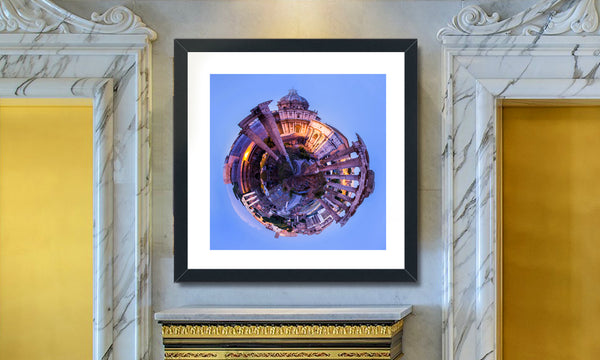I♥ROME
01 Bella Rome Ancient Ruins
I LOVE ROME | Bella Rome Ancient Ruins
ROME01
Rome, Italy
Dawn_Rome Panorama 360 Photography, highlighting the Roman Forum
16”x16” high quality print with a variety of framing options
The Heart of Rome
A SWIRLING PANORAMA bubble of the Roman Forum as the sun rises, golden over the Eternal City. Highlighting the Forum of Caesar, with other noted tourist attractions like the Temple of Vesta, Temple of Saturn, Temple of Castor and Pollux, Basilicia Julia and the Arch of Septimius Severus.
THE FAMOUS ROME FORUM historic sight, all wrapped up in one I LOVE ROME bubble. Rome, Italy ancient ruins sightseeing through a colorful dawn drenched panorama of this favorite tourist attraction, with the most renowned buildings highlighted.
THIS HIGH QUALITY 16” x 16” Limited Edition print is available with Black Framing 23" x 23" to compliment any décor. Get your limited edition unique slice of Rome, or delight your friends with the perfect holiday, birthday or housewarming gift!
Why I Love Rome
Seeing the striking contrast between the ancient and the modern on every street. Not just seeing how great the architecture is, but the enormity if the buildings. No one can be prepared for it ahead of time.
The mere mention Rome, Italy, caresses my soul with magical memories vivid to the eyes as well as the mind, and my stomach begins to flutter with excitement and anticipation.
There are many perfect memories that make it easy to love the Eternal City. A city to return to over & over again, with new revelations to experience. It's the art, architecture, food, culture and history. Sitting in Piazza Farnese nights, listening to the swifts diving in the dark blue sky above. Being surrounded by the congregated bones of the great men of past times who have filled history with their deeds and the earth with their renown. Living in a place so old puts things in perspective. If you want romance and carefree days and sights you will not see elsewhere, you must experience Rome.
There is something in Rome for every sense. The sights of the greatest masterpieces on earth, the sounds of the street musicians and the beautiful murmer of eloquent Italian being spoken, the tastes of delicious pastas and herbs and sauces and gelato and oil and wines, the smells of the delicious cuisine being cooked up and down every little street, the touch of your hand on a marble wall or the feel of the cool water from the most beautiful fountains ever made by man. The unexpected turn of a corner that leads you to another treasure. Wandering about the streets and piazzas and feeling myself shrink into insignificance in comparison with the handiwork of some of the greatest minds of all time. Walking into a church--any church-- and feeling the need to drop to my knees and weep.
Bella Roma, Sei un mito!
ABOUT THE ROMAN FORUM
Ancient Ruins, Center of Rome
The Roman Forum is a rectangular forum (plaza) surrounded by the ruins of several important ancient government buildings at the center of the city of Rome. Citizens of the ancient city referred to this space, originally a marketplace, as the Forum Magnum, or simply the Forum.
It was for centuries the center of Roman public life: the site of triumphal processions and elections; the venue for public speeches, criminal trials, and gladiatorial matches; and the nucleus of commercial affairs. Here statues and monuments commemorated the city's great men. The teeming heart of ancient Rome, it has been called the most celebrated meeting place in the world, and in all history.[1] Located in the small valley between the Palatine and Capitoline Hills, the Forum today is a sprawling ruin of architectural fragments and intermittent archaeological excavations attracting 4.5 million sightseers yearly.
Many of the oldest and most important structures of the ancient city were located on or near the Forum. The Roman kingdom's earliest shrines and temples were located on the southeastern edge. These included the ancient former royal residence, the Regia (8th century BC), and the Temple of Vesta (7th century BC), as well as the surrounding complex of the Vestal Virgins, all of which were rebuilt after the rise of imperial Rome.
Other archaic shrines to the northwest, such as the Umbilicus Urbis and the Vulcanal (Shrine of Vulcan), developed into the Republic's formal Comitium (assembly area). This is where the Senate—as well as Republican government itself—began. The Senate House, government offices, tribunals, temples, memorials and statues gradually cluttered the area.
Over time the archaic Comitium was replaced by the larger adjacent Forum and the focus of judicial activity moved to the new Basilica Aemilia (179 BC). Some 130 years later, Julius Caesar built the Basilica Julia, along with the new Curia Julia, refocusing both the judicial offices and the Senate itself. This new Forum, in what proved to be its final form, then served as a revitalized city square where the people of Rome could gather for commercial, political, judicial and religious pursuits in ever greater numbers.
Eventually much economic and judicial business would transfer away from the Forum Romanum to the larger and more extravagant structures (Trajan's Forum and the Basilica Ulpia) to the north. The reign of Constantine the Great saw the construction of the last major expansion of the Forum complex—the Basilica of Maxentius (312 AD). This returned the political center to the Forum until the fall of the Western Roman Empire almost two centuries later.
This list of monuments of the Roman Forum (Forum Romanum) includes existing and former buildings, memorials and other built structures in the famous Roman public plaza during its 1,400 years of active use (8th century BC — ca 600 AD). It is divided into three categories: (1) those ancient structures that can be seen today as ruins or reconstructions; (2) ancient structures that have vanished or exist only as fragments; and (3) churches of the later, Christian, era.
Many of the Forum's monuments were originally built in the periods of the Kingdom (753 BC-509 BC) and the Republic (509 BC-27 BC), although most were destroyed and rebuilt several times. The existing ruins generally date from the Imperial period (27 BC - 476 AD).
Significant Historic Ruins:
Temples
• Temple of Castor and Pollux (494 BC)
• Temple of Saturn (501 BC)
• Temple of Vesta (7th century BC)
• Temple of Venus and Roma (135)
• Temple of Antoninus and Faustina (141)
• Temple of Caesar (29 BC)
• Temple of Vespasian and Titus (79)
• Temple of Romulus (309)
Basilicas
• Basilica Aemilia
• Basilica Julia
• Basilica of Maxentius and Constantine
• Colossus of Constantine, colossal statue formerly in the west apse of the Basilica of Maxentius
Arches
• Arch of Septimius Severus
• Arch of Titus
• Arch of Maxima
Government buildings or official residences
• Regia, originally the residence of the kings of Rome or at least their main headquarters, and later the office of the Pontifex Maximus, the high priest of Roman religion.
• Curia Julia, official meeting place of the Roman Senate (built by Julius Caesar, 44 BC; later reconstruction by Diocletian, 305 AD)
• Tabularium, the records office of Rome; inside is the Tabularium Museum
• Portico Dii Consentes ("Portico of the Harmonious Gods")
• Atrium Vestae, the house of the Vestal Virgins.
• Tullianum, the prison used to hold various foreign leaders and generals.
Smaller monuments
• Rostra (New Rostra, Rostra Augusti), platform from which politicians made their speeches to the Roman citizens
• Umbilicus Urbis Romae, the designated centre ("navel") of the city from which, and to which, all distances in Rome and the Roman Empire were measured (probably identical with the Mundus Cereris)
• Milliarium Aureum After Augustus erected this monument, all roads were considered to begin here and all distances in the Roman Empire were measured relative to that point.
• Column of Phocas, the last monument built within the Forum.
• Lapis Niger ("Black Stone"), a very ancient shrine which was obscure even to the Romans.
• Plutei of Trajan (Plutei Traiani), now in the Curia Julia
Pools, springs
• The Lacus Curtius, the site of a mysterious pool venerated by Romans even after they had forgotten what it signified.
• The Lacus Iuturnae ("Spring of Juturna"), a healing pool where Castor and Pollux were said to have watered their horses
Roads, streets, staircases
• Gemonian stairssteps situated in the central part of Rome, leading from the Arx of the Capitoline Hill down to the Roman Forum.
• Clivus Capitolinus was the street that started at the Arch of Tiberius, wound around the Temple of Saturn, and ended at Capitoline Hill.
• Via Sacra, the famous processional street of Roman Triumphs; linked the Atrium Vestae with the Colosseum.
• Vicus Jugarius ("Street of the Yoke-Makers")








